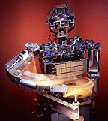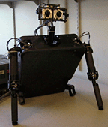



|
Future Deliverables
2001 - 2002:
Learned Coordinated Body Movement
- Human-like dynamics require joint control that is responsive to physics
of the world and robot body structure. This aspect of control will be
acquired through Cog exploring and learning about its workspace. Cog
will learn refined coordination of its torso, arm and hand movements
using a layered approach of reflex modeling, reflex inhibition and multi-joint
simulated muscles.
Object Preferences and Recall
- Cog will habituate, obey commands to attend, ignore or engage objects
using task-driven saliency. Cog will remember objects indexed by location
and visual appearance. It will be commanded to return its attention
to previously observed objects and locations.
Mirror Neuron Model Acquisition
- Cog will perform an action in the world while simultaneously its
mirror neuron model will incorporate the sensorimotor aspects of the
action (visual data and motor command sequences) into a representation
of the causality between the action and its consequences. Later, when
observing another person performing some action, Cog will enact a motor
sequence associated with the match of that action with one in its repertoire
that is likely to have the same consequence.
Precise Control in the Presence of Noise
- When controlling a robotic arm large state errors are introduced
by gravity and nonlinearities. Despite the presence of noise, Cog's
arm will precisely operate under parametric and non-parametric adaptive
control using a nonlinear sliding-modes controller.
Robust, Continuous Robot Operation
- A robot will continuously sense and act in its environment without
being shut down. It will regulate its use and acquisition of energy
and operate according to the drives stipulated in a motivational system.
|







